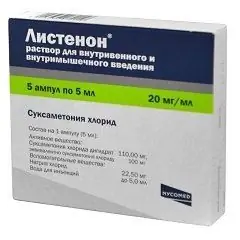- Author Rachel Wainwright [email protected].
- Public 2023-12-15 07:39.
- Last modified 2025-11-02 20:14.
Listenone
Listenon: instructions for use and reviews
- 1. Release form and composition
- 2. Pharmacological properties
- 3. Indications for use
- 4. Contraindications
- 5. Method of application and dosage
- 6. Side effects
- 7. Overdose
- 8. Special instructions
- 9. Application during pregnancy and lactation
- 10. Drug interactions
- 11. Analogs
- 12. Terms and conditions of storage
- 13. Terms of dispensing from pharmacies
- 14. Reviews
- 15. Price in pharmacies
Latin name: Lysthenon
ATX code: M03AB01
Active ingredient: suxamethonium chloride (suxamethonium chloride)
Producer: Nycomed Austria, GmbH (Austria)
Description and photo update: 2018-13-06
Prices in pharmacies: from 134 rubles.
Buy

Listenone is a drug with a muscle relaxant effect.
Release form and composition
The dosage form of Listenon is a solution for intravenous and intramuscular administration: colorless, transparent (in a cardboard box 1 pallet of 5 ampoules of colorless glass, 5 ml each).
Composition of 5 ml solution:
- active substance: suxamethonium chloride - 100 mg (suxamethonium chloride dihydrate - 110 mg);
- auxiliary components: sodium chloride - 22.5 mg; water for injection - up to 5 ml.
Pharmacological properties
Pharmacodynamics
Listenone is a depolarizing muscle relaxant. By blocking the conduction of the impulse to the terminal postsynaptic plates of the motor nerves, it causes reversible short-term paralysis of skeletal muscles. Suxamethonium binds to n-cholinergic receptors. In contrast to acetylcholine, its effect is a longer depolarization.
Stimulation is not possible as long as the suxamethonium remains bound to the receptor. In this regard, membrane depolarization becomes possible only after the separation of the receptor and suxamethonium. The difference between Listenon and the effect of non-depolarizing muscle relaxants is the rapid development of the action (over 60 seconds) and its short duration - 2-6 minutes. This ensures that muscle relaxation is highly manageable in accordance with the requirements of the surgery, and also avoids excessive duration of its action.
The sequence of muscle relaxation: circular muscle of the eye, chewing muscles, muscles of the limbs, abdominal wall, pharynx, diaphragm.
Pharmacokinetics
Listenone after intravenous administration has an effect in 30-60 seconds; the duration of the effect is approximately 2-6 minutes.
The action of the drug when administered intramuscularly develops after 75 seconds. Its duration is: for adults - 3 minutes, for children - 3.5 minutes, for newborns - 4 minutes.
The short duration of Listenon's action is associated with the rapid inactivation of suxamethonium by plasma cholinesterase: after administration, most of the dose is inactivated immediately, before reaching the end plates of the motor nerves. The substance is hydrolyzed to form succinyl monocholine and choline (the half-life from plasma is less than 60 seconds). Succinyl monocholine is one of the non-depolarizing muscle relaxants, its activity in comparison with the starting substance is 20-50 times lower. The metabolic rate slows down further. Succinylmonocholine breaks down into active (choline) and inactive (succinic acid) metabolites.
The rate of excretion depends on the hydrolysis of suxamethonium by plasma cholinesterase. Approximately 10% of the substance is excreted unchanged by the kidneys.
Indications for use
According to the instructions, Listenone is used exclusively under general anesthesia in the following cases:
- intubation of the trachea (to relax the skeletal muscles);
- electrical impulse therapy (to reduce the severity of seizures);
- surgical interventions in the presence of a high risk of regurgitation (intestinal obstruction, emergency caesarean section, acute abdomen, emergency operations with an unreleased stomach).
Contraindications
Absolute:
- penetrating wounds of the eye, accompanied by increased intraocular pressure;
- tendency to malignant hyperthermia;
- hyperkalemia and conditions that increase its risk (severe renal failure, potassium supplementation), due to possible hyperkalemic cardiac arrest;
- disorders of neuromuscular conduction associated with myotonia, poliomyelitis, amyotrophic lateral sclerosis, multiple sclerosis, all forms of muscular dystrophy, severe myasthenia gravis;
- prolonged immobilization;
- severe abdominal infections, sepsis;
- severe burns, multiple injuries;
- increased intracranial pressure;
- congenital cholinesterase deficiency;
- violation of innervation, leading to secondary muscle atrophy (transverse syndrome);
- lactation period;
- individual intolerance to the components of the drug.
Relative (Listenone is prescribed under medical supervision):
- heart disease;
- hypermagnesemia;
- hypothermia;
- hypokalemia;
- hypocalcemia;
- lung disease;
- conditions occurring with a decrease in cholinesterase activity;
- pregnancy.
Instructions for use of Listenon: method and dosage
Intravenous administration
Listenone is administered intravenously during general anesthesia - a single slow jet injection for 10-30 seconds.
Application scheme:
- adults and children over 12 years of age: tracheal intubation - a single dose of 1-1.5 mg / kg (no more than 150 mg); electroimpulse therapy (prevention of complications - seizures, muscle / tendon detachment) - 0.5-0.7 mg / kg;
- children 1-12 years old: 1 mg / kg;
- children under 1 year: 1-2 mg / kg. Newborns, due to the larger volume of distribution, require a large dose of suxamethonium in mg / kg.
The dosage of Listenone in obese patients should be calculated on the basis of ideal body weight, not actual body weight.
The drug should not be administered as a long-term infusion.
Compatible with blood, 0.9% sodium chloride solution, 6% dextran solution, Ringer's solution, 5% dextrose solution, 5% fructose solution. It is not recommended to mix with any other substances / solutions Listenon.
Intramuscular injection
Intramuscularly Listenone is administered in cases of poor access to the superficial veins (in particular in children) or in emergency situations when rapid endotracheal intubation is required.
The recommended dosage regimen for all age groups of patients is 3-4 mg / kg (maximum 150 mg).
Side effects
Possible adverse reactions (> 10% - very common;> 1% and 0.1% and 0.01% and <0.1% - rarely; <0.01%, including isolated messages - very rare):
- musculoskeletal system: very often - muscle fasciculations, myalgia (as a result of muscle fasciculations, often occurs in the shoulder girdle, neck, chest and back, especially in middle-aged patients); infrequently - minor trismus (can be reduced with propofol or a non-depolarizing muscle relaxant in a small dose); rarely - muscle contractions instead of relaxation (often observed against the background of dystrophic myotonia / congenital myotonia), prolonged paralysis; very rarely - acute rhabdomyolysis, occurring with established / unidentified disorders of neuromuscular conduction;
- immune system: often - allergic reactions (in the form of sharp redness of the skin, urticaria); rarely - bronchospasm; very rarely - anaphylactic shock, occurring with sudden redness of the skin, with / without a decrease in blood pressure and bronchospasm;
- respiratory system: rarely - prolonged apnea (against the background of impaired plasma cholinesterase activity), laryngospasm; very rarely - pulmonary / laryngeal edema, late respiratory failure (against the background of neuromuscular transmission disorders);
- blood and lymphatic system: very often - increased serum potassium concentration (most often there is a slight increase of 0.05 mmol / l), myoglobinemia (found in children in 20% of cases, less often in adults; the development of the disorder does not depend on the dose and can develop with / without muscle fasciculations); very rarely - ventricular fibrillation and cardiac arrest (associated with hyperkalemia);
- metabolism and nutrition: very rarely - hyperkalemia (can be life-threatening), porphyria, malignant hyperthermia with / without muscle rigidity (spasm of the masticatory muscles), hemoglobinuria, increased concentration of CO 2 at the end of exhalation, severe acidosis, increased body temperature, cardiovascular -vascular complications (in the form of tachyarrhythmias, unstable blood pressure);
- organ of vision: often - increased intraocular pressure;
- nervous system: often - increased intracranial pressure;
- digestive system: often - increased salivation, increased intragastric pressure (the risk of regurgitation is observed in pregnant patients, as well as against the background of stomach / intestinal atony, hiatal hernia, ascites, abdominal tumors);
- cardiovascular system: very often - arrhythmias, mild bradycardia; often - decrease / increase in blood pressure; infrequently - tachycardia; very rarely - ventricular fibrillation, ventricular arrhythmias, cardiac arrest, hypercalcemia (especially in children with unidentified skeletal muscle disease), heart failure;
- kidneys and urinary tract: rarely - increased activity of creatine phosphokinase and myoglobinuria (mainly in children against the background of combined use with halothane); very rarely - myoglobinuria, leading to renal failure (mainly in patients with diagnosed or latent muscular dystrophy);
- skin and subcutaneous tissue: often - redness of the skin (associated with the release of histamine).
Overdose
The main symptoms: long-term blockade of neuromuscular transmission, continuing after the end of the operation and anesthesia. It manifests itself in the form of muscle weakness, decreased inspiratory volume, respiratory reserves, or apnea.
Therapy: maintaining adequate breathing and airway patency until muscle tone is fully restored.
special instructions
Listenone leads to the development of paralysis of the respiratory muscles without affecting the patient's consciousness. During general anesthesia, the drug should be administered only by an experienced anesthesiologist who has access to means for mechanical ventilation, tracheal intubation, and, if necessary, resuscitation.
The parasympathetic effects of Listenone can vary (asystole, bradycardia, hypersalivation, hypotension). Often their development can be prevented / mitigated by atropine.
Adverse reactions to the heart in most cases occur in children (at the onset of bradycardia, then tachycardia, ventricular extrasystole and substituting junctional rhythm are possible). Deaths in children and adolescents have been reported as a result of resistance to resuscitation therapy. In some cases, unrecognized disorders of neuromuscular transmission were noted in patients.
Listenone should not be given as a continuous infusion.
Suxamethonium chloride is inactivated during hydrolysis by pseudocholinesterase or plasma cholinesterase; therefore, the duration of the Listenone effect depends, first of all, on the activity of these enzymes.
With cholinesterase / pseudocholinesterase deficiency, the effect of the drug may increase markedly. Cholinesterase deficiency can be observed for congenital reasons or occur against a background of severe hepatic dysfunction, hypothyroidism, end-stage renal failure or severe diseases of various etiologies (cachexia, malignant tumors), burns, or taking certain medications.
Physiological inhibition of cholinesterase activity is observed in the following groups of patients: newborns, women in late pregnancy, and the elderly. A significant increase in the duration of action of Listenone is of clinical significance, mainly for patients with genetic deficiency of plasma cholinesterase. Such patients, under certain circumstances, must continue to be on mechanical ventilation for several hours. Repeated administration of Listenone, as well as its continuous infusion, can lead to a change in the ability of suxamethonium to induce neuromuscular block (the required cumulative dose is 5-10 mg / kg).
The introduction of Listenone may be accompanied by the intake of a significant amount of potassium into the cell. An increase in serum potassium concentration can cause the development of life-threatening hyperkalemia, with the occurrence of ventricular fibrillation and asystole. Patients with severe burns, kidney failure, or multiple injuries are at particular risk.
After the administration of Listenone, temporary muscle fasciculations may appear, leading to muscle pain or myalgia. Precurarization (introduction of non-depolarizing muscle relaxants in low doses) makes it possible to reduce primary muscle fasciculations and myalgia.
The effects of suxamethonium can be potentiated and prolonged by hypothermia, which is associated with a slowdown in physical and biochemical membrane processes. Strengthening and lengthening of the effect of the drug is observed with hypermagnesemia and hypocalcemia.
Influence on the ability to drive vehicles and complex mechanisms
For at least 24 hours after the administration of Listenone, you should not drive vehicles.
Application during pregnancy and lactation
- pregnancy: Listenone can be used under medical supervision in cases where the expected benefit is higher than the possible risk. It is necessary to take into account the possible increase in the duration of the drug's action. After delivery, plasma cholinesterase activity returns to normal after about 6-8 weeks. The solution does not penetrate the placenta;
- lactation period: therapy is contraindicated.
Drug interactions
Strengthening / lengthening the effect of Listenon is promoted by the following drugs:
- cholinesterase inhibitors (neostigmine methyl sulfate), including eye drops containing cholinesterase inhibitors (ecothiopath chloride, edrophonium chloride, pyridostigmine iodide);
- antiepileptic drugs;
- lithium salts;
- antibiotics, mainly aminoglycosides (neomycin, gentamicin, streptomycin);
- means for inhalation anesthesia (sevoflurane, desflurane, enflurane, isoflurane);
- estrogens and hormonal contraceptives;
- corticosteroids;
- monoamine oxidase inhibitors (phenelzine) and some antipsychotics (perphenazine);
- cimetidine, oxytocin;
- sympathomimetics;
- local anesthetics (lidocaine, procaine);
- magnesium sulfate (the infusion of magnesium salts should be stopped 20-30 minutes before the administration of Listenone);
- alcohol and drugs that depress the central nervous system;
- metoclopramide;
- beta-blockers;
- class I antiarrhythmic drugs;
- slow calcium channel blockers and loop diuretics.
A decrease in the Listenon effect is observed with combined use with atropine and against the background of concomitant plasma or whole blood transfusion.
Other possible interactions:
- cardiac glycosides: potentiation of the effect, which can cause the development of arrhythmias;
- sodium thiopental: incompatibility, drugs should not be mixed or administered at the same time.
Analogs
The analogue of Listenon is Suxamethonium chloride.
Terms and conditions of storage
Store in a place protected from light at a temperature of 2-8 ° C. Keep out of the reach of children.
The shelf life is 3 years.
Terms of dispensing from pharmacies
Dispensed by prescription.
Reviews about Listenone
There are practically no reviews of Listonone, since it is used under general anesthesia.
The price of Listenone in pharmacies
The approximate price for Listenon (5 ampoules of 5 ml per package) is 125-140 rubles.
Listenon: prices in online pharmacies
|
Drug name Price Pharmacy |
|
Listenone 20 mg / ml solution for intravenous and intramuscular administration 5 ml 5 pcs. 134 r Buy |

Anna Kozlova Medical journalist About the author
Education: Rostov State Medical University, specialty "General Medicine".
Information about the drug is generalized, provided for informational purposes only and does not replace the official instructions. Self-medication is hazardous to health!






